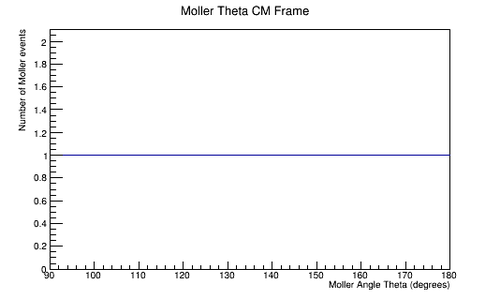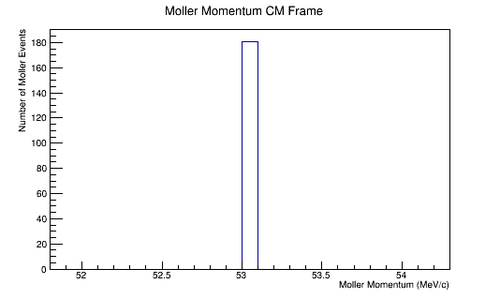Difference between revisions of "Uniform distribution in Energy and Theta LUND files"
| Line 16: | Line 16: | ||
<center><gallery widths=500px heights=400px> | <center><gallery widths=500px heights=400px> | ||
| − | File:MolThetaCM_spread.png|'''Figure 4.1.1:''' An Isotropic CM frame distribution of | + | File:MolThetaCM_spread.png|'''Figure 4.1.1:''' An Isotropic CM frame distribution of final scattering angle theta for Moller electrons. |
| − | File:MolMomCM_spread.png|'''Figure 4.1.2:''' An CM frame distribution for an isotropic distribution in | + | File:MolMomCM_spread.png|'''Figure 4.1.2:''' An CM frame distribution for an isotropic distribution in final scattering angle theta for Moller electrons. |
</gallery></center> | </gallery></center> | ||
Revision as of 18:17, 30 May 2017
4.1 Uniform Distribution in Energy and Theta LUND files
Due to the fact that GEMC simulations will utilize particle momentum in the lab frame, the LUND files must contain lab frame information. In addition, all the data given is for 11GeV electrons that have not yet had the chance to interact with the target material. In the lab frame there are 2 degrees of freedom, i.e. and . The number of degrees of freedom can be reduced to 1 degrees of freedom in the center of mass frame of reference since the Moller differential cross section does not rely on . Since the Moller differential cross-section only relies on in this frame it implies for a given angle we should find the same results for any given angle . To ensure that all the electrons simulated in GEMC are Moller electrons, this is made easier by first creating them in the center of mass frame after scattering.
The LUND file is created by creating an isotropic distribution of electrons within the Moller center of mass frame of reference after scattering. These particles are uniformly distributed through the angle theta with respect to the beam line in the range 90-180 in the center of mass frame. This is initially done at a set angle phi (0 degrees) with respect to the perpendicular components with respect to the beam line.

